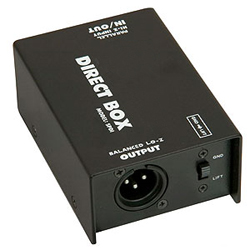
However, if that instrument is connected through the DI to an amplifier, it also introduces a second grounding point at the amplifier.
Slight differences in the actual resistance to ground can exist between the amplifier and the mixing console, and this can cause AC current to flow in the shield.
This is called a ground loop, with the 60 Hz signal “riding” on the shield, radiating into the center conductor. The result is hum.
Similarly, in the case of AC-powered keyboards or preamps, a ground connection through the DI can also set up a ground loop.
As a rule of thumb, the ground switch is left in the “ground” position unless there is a hum problem.
Isolating the grounds by placing the switch in the “lift” position can help reduce or eliminate it.
Active
The same conversion that occurs with a passive DI can also be accomplished with an active electronic circuit.
An advantage of using an active circuit is that it can be fine-tuned to produce a wider frequency response than can be achieved with an entirely passive DI.
However, active DIs require a power source – phantom power from the mixer or internal batteries.
When converting impedance with a transformer, the impedance and signal reduction required for the output dictates that the primary of the transformer be in about the 20 kOhm range.
Although this is a fairly high impedance, the high-frequency component of the applied signal would be better preserved if the input impedance were even higher. Active
DIs accomplish this with a very high input impedance of 1 million ohms or more.
Al Keltz heads up Whirlwind technical support, http://www.whirlwindusa.com
